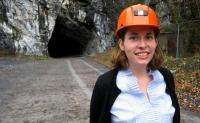Underground mine ventilation subject of study

The Virginia Tech mining and minerals engineering department has received a $1.24 million, five-year contract by the National Institute for Occupational Safety and Health (NIOSH) to study the effects of roof falls, bumps, or explosions on underground mine ventilation systems.
Kray Luxbacher, an assistant professor with the College of Engineering's mining department, is serving as principal investigator of the study. She will be supported by fellow faculty members Saad Ragab, a professor in the department of engineering sciences and mechanics, and Robert Boggess, research associate, and Harold McNair, professor emeritus of chemistry in the College of Science's department of chemistry. They bring expertise in gas chromatography and computational fluid mechanics to this interdisciplinary project.
Titled "Development of a Method for the Remote Characterization of Underground Mine Ventilation Controls by Multiple Tracer Gases," the project will use gas tracers as a means of remotely ascertaining information about ventilation control systems following a mine collapse or explosion.
"This project has the potential to provide insight into the status of a mine ventilation system following a serious incident, when information is limited and decisions impacting the safety of mine rescue personnel and miners must be made," said Luxbacher.
Utilizing scaled models and real working mines, the study will allow for the rapid collection tracer gas profiles under normal operating conditions, as well as a simulated emergency, in an underground coal mine. It is hope that the new process, using computational fluid mechanics, can determine the state of ventilation controls, including the nature and general location of damage, by comparing collected and simulated tracer gas profiles.
The grant will allocate $250,000 each year for five years. Phase 1 will consist of developing project tools, such as a computer program which will allow multiple users to employ computational fluid dynamics modeling, and an experimental apparatus for testing tracer gases. Additionally, a tracer gas other than sulfur hexafluoride -- the industry standard in such mine ventilation tests - will be identified and tested in both the laboratory and field. Additional gases allow complex mine ventilation systems to be evaluated more quickly, Luxbacher said.
This NIOSH grant is designed to increase mine ventilation expertise thorough graduate education and to develop technologies that improve mine safety and health. "The average age of people employed in the mining industry is fairly high, and the exodus of experienced personnel is affecting research and higher education," Luxbacher said. "This grant is a proactive step by NIOSH to increase expertise in mine ventilation, which is key to maintaining safe mines and advancing mine safety and health."
Source: Virginia Tech